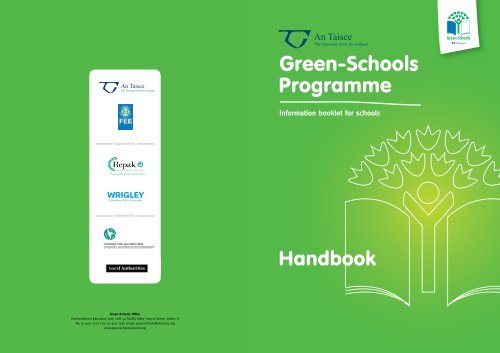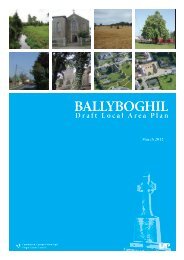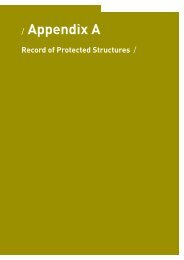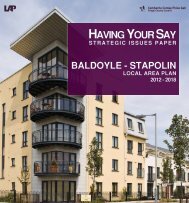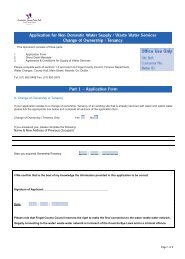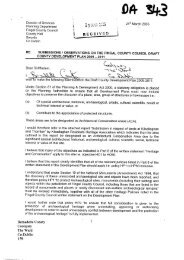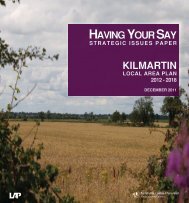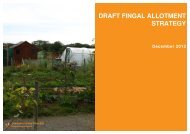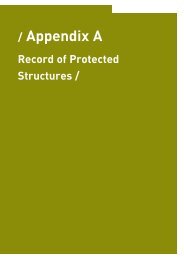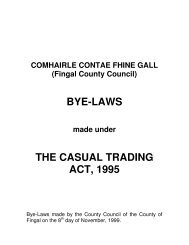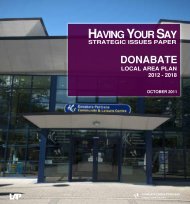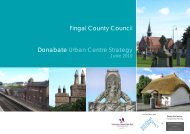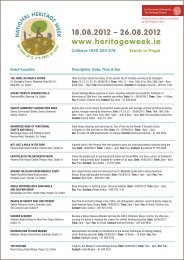Green Schools handbook - Fingal County Council
Green Schools handbook - Fingal County Council
Green Schools handbook - Fingal County Council
Create successful ePaper yourself
Turn your PDF publications into a flip-book with our unique Google optimized e-Paper software.
Sponsored by:<br />
Supported by:<br />
<strong>Green</strong>-<strong>Schools</strong> Office<br />
Environmental Education Unit, Unit 5a Swift’s Alley, Francis Street, Dublin 8<br />
Tel: 01 400 2222 Fax: 01 400 2285 Email: greenschools@antaisce.org<br />
www.greenschoolsireland.org<br />
<strong>Green</strong>-<strong>Schools</strong><br />
Programme<br />
Information booklet for schools<br />
Handbook
An Taisce – The National Trust for Ireland is the foremost environmental organisation in Ireland. Its range of interests extends from the<br />
natural heritage of land, air, water, flora and fauna, to the heritage of buildings and gardens. Through its local, national and international<br />
networks, it seeks to educate, inform and lead public opinion on the environment and influence policy and development. Strategies to<br />
achieve these aims include awareness and education projects, for example:<br />
FEE (The Foundation for Environmental Education) – seeks to promote environmental education by carrying out campaigns and improving<br />
awareness of the importance of environmental education. It is composed of a network of organizations which undertake individual projects<br />
in their own countries and participate in international efforts. An Taisce as the Irish member of FEE co-ordinates these campaigns in Ireland.<br />
Congratulations to you on becoming a part of <strong>Green</strong>-<strong>Schools</strong>. I am proud to be associated with this long-running and very successful<br />
programme. Over 80% of all primary and secondary schools are now involved. The programme promotes long term environmental planning<br />
for schools and encourages practical actions to protect the environment. An additional benefit is that schools can often make significant<br />
savings by addressing wastage. Over the years <strong>Green</strong>-<strong>Schools</strong> has involved many thousands of our young people, learning more about<br />
their environment and how to live in a more sustainable manner. What you learn on the programme will help you to become a more active<br />
and environmentally responsible citizen. You will learn about the importance of protecting and improving our environment and about the<br />
actions that you can take yourself. I am delighted that my Department continues to support this excellent programme. The success of the<br />
programme depends on expertise, goodwill, hard-work and cooperation from a wide range of organisations and individuals. I would like to<br />
acknowledge the contributions of An Taisce, local authorities, parents and particularly the schools.<br />
Mr. Phil Hogan, T.D.,<br />
Minister for the Environment, Community and Local Government<br />
Education Unit programmes:<br />
<strong>Green</strong>-<strong>Schools</strong> www.greenschoolsireland.org<br />
Blue Flag www.beachawards.ie<br />
Clean Coast www.cleancoastsireland.org<br />
National Spring Clean www.nationalspringclean.org<br />
<strong>Green</strong> Home www.greenhome.ie<br />
<strong>Green</strong> Campus www.greencampusireland.org<br />
<strong>Green</strong> Communities www.antaisce.org<br />
<strong>Green</strong> Pre-<strong>Schools</strong> www.greenpreschoolsireland.org<br />
<strong>Green</strong>ing Communities www.greeningcommunities.ie<br />
An Taisce operates <strong>Green</strong>-<strong>Schools</strong> in Ireland in partnership with Local Authorities. Local Authorities not only provide funding for the<br />
programme but also provide an excellent on the ground support network for schools through their Environmental Education and Awareness<br />
Officers. The partnership is seen as the key to the success of the <strong>Green</strong>-<strong>Schools</strong> programme in Ireland.<br />
Repak – are proud lead sponsors of the <strong>Green</strong>-<strong>Schools</strong> programme in Ireland and recognise the important role our younger generation plays<br />
in maintaining and sustaining our earth’s natural resources. Repak is a not for profit voluntary member’s based packaging recycling scheme<br />
established under a voluntary agreement between industry and the Department of the Environment, Heritage and Local Government. It was<br />
established as industry’s response to the obligations places on Ireland by the EU directive on Packaging Waste (94/62/EC) and is the only<br />
government approved packaging compliance scheme under the Waste Management (Packaging) Regulations 2007. Repak, Ireland’s <strong>Green</strong><br />
Dot company was established to acquire membership from such obligated companies to drive Ireland’s packaging recycling rates. Repak<br />
succeeded in reaching and exceeding Ireland’s EU National Packaging Recovery and Recycling Target of 25% of packaging waste in 2001 and<br />
is well on the way to achieving our 2005 EU packaging recovery target of 50%.<br />
The Wrigley Company Ltd. is delighted to support the <strong>Green</strong>-<strong>Schools</strong> Programme as part of their on-going commitment to promote antlittering<br />
strategies. Other examples of their commitment to schools and young people include sponsorship of ECO UNESCO’s CD Rom and<br />
web management system and Foróige’s Citizenship Programme Awards. All these programmes are designed to promote proper disposal of<br />
chewing gum within the overall context of ant-littering strategies and environmental education initiatives.<br />
This booklet is printed on COCOON® paper/board, which is manufactured from FSC approved 100% recycled pulp, supporting responsible use of forest resources.<br />
Designed by www.create.ie.<br />
What is <strong>Green</strong>-<strong>Schools</strong>?<br />
Most young people care deeply about environmental issues, and wish to<br />
make a positive change to the environment around them. The <strong>Green</strong>-<strong>Schools</strong><br />
programme provides an ideal way for fostering environmental awareness in the<br />
entire school in a way that links to many curriculum subjects.<br />
The programme is based on the EU EMAS (Eco-Management and<br />
Auditing System) approach, and encompasses four principle aspects:<br />
<strong>Green</strong>-<strong>Schools</strong> is an international environmental education programme, offering a well-defined,<br />
controllable way for schools to take environmental issues from the curriculum and apply them to<br />
the day-to-day running of their school. The <strong>Green</strong>-<strong>Schools</strong> programme is run by FEE (Foundation for<br />
Environmental Education), and is known internationally as “Eco-<strong>Schools</strong>”. <strong>Green</strong>-<strong>Schools</strong> are now<br />
represented in over 52 countries from all over the world.<br />
<strong>Green</strong>-<strong>Schools</strong> is holistic. It aims to make environmental awareness and action an intrinsic part of the<br />
life and ethos of a school. This should include the students, teachers, non-teaching staff and parents,<br />
as well as the local authority, the media and local business. <strong>Green</strong>-<strong>Schools</strong> endeavours to extend<br />
learning beyond the classroom and develop responsible attitudes and commitment, both at home<br />
and in the wider community.<br />
<strong>Green</strong>-<strong>Schools</strong> is both a programme and an award scheme. Any school using the guidelines given in<br />
this <strong>handbook</strong> can adopt the programme to their needs. While the <strong>Green</strong> Flag award will be given<br />
to schools that complete all the essential elements of the <strong>Green</strong>-<strong>Schools</strong> programme, it should be<br />
remembered that the programme is flexible, and that different schools will find different routes to<br />
achieving <strong>Green</strong>-<strong>Schools</strong> status. The <strong>Green</strong> Flag award is now established as a well respected and<br />
recognised eco-label.<br />
<strong>Green</strong>-<strong>Schools</strong> is a long-term programme. The <strong>Green</strong>-<strong>Schools</strong> award as outlined above takes the form<br />
of a <strong>Green</strong> Flag. This can be flown outside school or displayed in the foyer. However, it is important<br />
to remember that the programme is one of continual reduction of the schools environmental impact.<br />
Therefore, the award requires renewal every two years. This links in with the themed nature of the<br />
<strong>Green</strong>-<strong>Schools</strong> programme as outlined in this <strong>handbook</strong>.<br />
www.greenschoolsireland.org<br />
Log on for more information<br />
about the programme<br />
<strong>Green</strong>-<strong>Schools</strong> Programme<br />
01
02<br />
International and national<br />
aspects of ‘<strong>Green</strong>-<strong>Schools</strong>’<br />
International ‘Eco-<strong>Schools</strong>’<br />
‘Eco-<strong>Schools</strong>’ is an initiative of FEE (Foundation for Environmental Education), and is referred to<br />
by a number of different names in member countries e.g. Eco-Scholen in Belgium, Eco-<strong>Schools</strong> in<br />
the U.K, <strong>Green</strong>-<strong>Schools</strong> in Ireland and Umweltshule in Germany (see www.eco-schools.org for more<br />
information). ‘Eco-<strong>Schools</strong>’ began in 1994 as a pilot project in the UK, Denmark, Germany, France, and<br />
Portugal. In 2001, ‘Eco-<strong>Schools</strong>’ moved from a European initiative to one of international dimensions<br />
with the inclusion of Africa, South America, Oceania, and Asia. Eco-<strong>Schools</strong> began in 1994 as a pilot<br />
project in the UK, Denmark, Germany, France and Portugal. In 2001, Eco-<strong>Schools</strong> moved from a<br />
European initiative to an international one.<br />
‘<strong>Green</strong>-<strong>Schools</strong>’ Ireland<br />
<strong>Green</strong>-<strong>Schools</strong> Programme<br />
www.eco-schools.org<br />
Log on for more information<br />
<strong>Green</strong>-<strong>Schools</strong> is operated by the Non-Governmental Organisations (NGOs) that are the FEE<br />
members in each of the participating countries. An Taisce, as a FEE member for Ireland,<br />
co-ordinates the programme in this country. The programme was introduced to Ireland in 1997<br />
and has enjoyed sustained growth each year. Today the Irish <strong>Green</strong>-<strong>Schools</strong> programme is among<br />
the most successful internationally.<br />
In Ireland <strong>Green</strong>-<strong>Schools</strong> is operated in partnership with Local Authorities. This partnership has<br />
proved very successful, with Local Authorities working closely with schools on the ground. Since 2001<br />
<strong>Green</strong>-<strong>Schools</strong> has been a fully national programme, with all 34 <strong>County</strong> and City <strong>Council</strong>s involved.<br />
The <strong>Green</strong>-<strong>Schools</strong> programme is therefore part of a three-way collaboration involving schools, An<br />
Taisce and Local Authorities.<br />
<strong>Green</strong>-<strong>Schools</strong>’ themes<br />
<strong>Green</strong>-<strong>Schools</strong> covers a number of different themes, beginning with litter and waste minimisation and<br />
followed by themes such as energy, water, travel, and biodiversity. As your <strong>Green</strong>-<strong>Schools</strong> programme<br />
evolves further themes will be introduced.<br />
In order to implement the <strong>Green</strong>-<strong>Schools</strong> programme most effectively, the <strong>Green</strong>-<strong>Schools</strong> Office<br />
encourages schools to resist taking on all themes at the same time. <strong>Schools</strong> begin by examining the<br />
litter and waste theme and will receive materials providing information on how best to implement the<br />
<strong>Green</strong>-<strong>Schools</strong> programme for litter and waste. Upon renewal of the award subsequent themes may<br />
then be tackled. The sequence of the themes is outlined below:<br />
Litter and Waste<br />
Examines the Litter impact of litter and waste on the environment and explores<br />
practical means for reducing and minimising the amount of litter and waste<br />
produced by the school.<br />
Energy<br />
Suggests ways in which all members of the school can work together to increase<br />
awareness of energy issues and to improve energy efficiency within the school.<br />
Water<br />
Provides an introduction to the importance of water both locally and globally and<br />
raises awareness<br />
Water<br />
of how simple actions can substantially cut down water use.<br />
Travel<br />
Energy<br />
Transport<br />
Suggests ways for pupils, staff and local government to work together to raise<br />
awareness of transport issues and come up with practical solutions that will make<br />
a real difference to pupils’ everyday lives.<br />
Biodiversity<br />
Biodiversity<br />
Examines the flora and fauna present in the school environment and suggests<br />
ways to increase the levels of biodiversity around the school and raises the pupils<br />
awareness of the biodiversity and nature.<br />
Citizenship<br />
Global Citizenship<br />
Examines what our rights and responsibilities are on a National, European and<br />
Global scale and encourages staff, students and parents to look at the impacts our<br />
consumptions habits have on other parts of the world.<br />
<strong>Green</strong>-<strong>Schools</strong> Programme<br />
03
04<br />
Benefits and requirements of the ‘<strong>Green</strong>-<strong>Schools</strong>’ Programme<br />
The <strong>Green</strong>-<strong>Schools</strong> Programme offers your school opportunities to:<br />
• Help develop children’s decision-making skills<br />
• Build students’ confidence and sense of citizenship through participation<br />
• Supply curriculum materials and ideas for projects and events<br />
• Gain access to a network of support agencies<br />
• Link with other schools in Ireland and internationally<br />
• Gain a prestigious award<br />
• Provide local and national publicity<br />
• Save money<br />
• Reduce waste and litter<br />
• Improve the school environment<br />
• Reduce energy and water consumption levels<br />
• Tackle and improve transport issues around the school community<br />
• Involve the local community.<br />
It requires:<br />
• The support of the Principal and Board of Management<br />
• The willingness to involve children in decision-making and action at every stage<br />
• Active involvement of staff and support from parents and the local community<br />
• The willingness to take action to instigate long-term change.<br />
Four stages of the Award Scheme<br />
The award has four main stages:<br />
1<br />
2<br />
1<br />
1<br />
Registration<br />
Implementation of<br />
<strong>Green</strong>-<strong>Schools</strong> Programme<br />
3<br />
4<br />
1<br />
1<br />
Applying for your Award<br />
Award Renewal<br />
Note: that there are minimum requirements that must be fulfilled and that the school must have<br />
implemented all of the seven steps before applying for an award. The following pages cover each of<br />
these seven steps in detail.<br />
Registration<br />
Before you register your school you need to be sure you have sufficient support from the Principal<br />
and other staff. We suggest that one or more core members of staff read this <strong>handbook</strong> and present<br />
an outline of the <strong>Green</strong>-<strong>Schools</strong> programme to colleagues and the school’s Board of Management.<br />
The presentation should cover the:<br />
• Benefits to the school;<br />
• Seven essential elements as described on the following pages;<br />
• Scheme’s flexibility;<br />
• Intention to start with small, achievable targets;<br />
• Long-term nature of the programme;<br />
• Programme’s potential to act as a focus for developing a whole-school policy for<br />
environmental education.<br />
If the idea is received with sufficient enthusiasm for it to continue you will need to register your<br />
school. You can register at any time of the year. You will receive a certificate of registration along<br />
with your <strong>Green</strong>-<strong>Schools</strong> theme booklet. To register log on to www.greenschoolsireland.org.<br />
www.greenschoolsireland.org<br />
Log on to register for the<br />
<strong>Green</strong>-<strong>Schools</strong> programme<br />
<strong>Green</strong>-<strong>Schools</strong> Programme <strong>Green</strong>-<strong>Schools</strong> Programme<br />
05
06<br />
The <strong>Green</strong>-<strong>Schools</strong> Programme<br />
The <strong>Green</strong>-<strong>Schools</strong> programme is based on 7 steps. These steps are<br />
outlined below:<br />
<strong>Green</strong>-<strong>Schools</strong> Programme<br />
6<br />
2<br />
5<br />
1<br />
3<br />
<strong>Green</strong>-<strong>Schools</strong> Committee<br />
Environmental Review<br />
4 Monitoring and Evaluation<br />
7 <strong>Green</strong> Code<br />
Action Plan<br />
Curriculum Work<br />
7 step<br />
Involving and Informing<br />
programme<br />
1<br />
Aim<br />
1<br />
<strong>Green</strong>-School<br />
Committee<br />
The <strong>Green</strong>-<strong>Schools</strong> Committee aims to direct and<br />
address all phases of the <strong>Green</strong>-<strong>Schools</strong> Programme.<br />
It is the driving force of the programme and should<br />
ensure that all of the 7 steps are carried out.<br />
Composition and Selection<br />
Ideally, the committee should be as representative of the whole school as possible. It should<br />
primarily be made up of students (making up the majority of the committee members whenever<br />
possible) and could also incorporate a combination of teachers, the Principal or a member of the<br />
Board of Management, non-teaching staff (particularly the school caretaker), parents, and any other<br />
interested and applicable members of the local community.<br />
Regarding size and operation, it should be remembered that there is no set formula or rules for a<br />
successful committee. Often the committee is made up of volunteers from the student body as well<br />
as teachers and other interested members of the community. In some cases schools will go through<br />
a full election process with manifestos, election speeches, canvassing, election posters, and ballots<br />
in order to fill the various positions on the committee! Many secondary schools select the committee<br />
members from the CSPE or Transition Year classes that are undertaking the <strong>Green</strong>-<strong>Schools</strong> programme<br />
or a similar module as part of their course work. It is important, however, to ensure that the student<br />
members of the committee are as representative as possible of the different classes and age groups<br />
in the school. This will also ensure greater continuity in your programme over the years.<br />
The committee may take different forms depending on the age and ability of the students.<br />
A formal committee where the members are assigned different roles e.g. Chairperson, Minute Taker,<br />
Timekeeper etc. has worked well even with young students but less formal committees are fine if<br />
they achieve the same purpose. However informal it is, the committee should be representative of<br />
all and should keep records of meetings held and decisions made (you are asked to include a sample<br />
of your meeting minutes in the Application form).<br />
The purpose of the committee is to:<br />
• Ensure the six other steps are successfully adopted and implemented<br />
• Give students responsibility and to make them recognise that their ideas are valued<br />
• Ensure the views of all members of the school community are heard and acted upon<br />
where possible<br />
• Ensure the continuity of the programme<br />
• Link with school management and the local community.<br />
<strong>Green</strong>-<strong>Schools</strong> Programme<br />
07
08<br />
2 Environmental<br />
Review<br />
Aim<br />
Review<br />
<strong>Green</strong>-<strong>Schools</strong> Programme<br />
The aim of the review is to identify the initial situation<br />
within the school regarding the environmental theme<br />
under investigation (e.g. litter and waste, energy etc.).<br />
Before you even start to think about the solution you need to find out more about the problem.<br />
The Environmental Review is an open-ended checklist of all aspects of the school’s impact on the<br />
environment in relation to the theme you are working on.<br />
You are required to complete specific required actions for your review, however we also recommend<br />
that schools complete other suggested options too. <strong>Schools</strong> are encouraged to come up with their<br />
own ideas to build on their environmental review, in order to gain a full understanding of any issues<br />
present within the school.<br />
The Environmental Review allows you to:<br />
• Assess the initial situation of the school<br />
• Identify areas for improvement<br />
• Gauge progress of the <strong>Green</strong>-<strong>Schools</strong> Programme<br />
• Help students and the rest of the school community understand the impacts<br />
• Help to prioritise the actions to be taken.<br />
In summary, your environmental review should:<br />
• Give a clear indication of the schools environmental impact for the specific theme<br />
(e.g. the amount of waste produced, the amount of energy consumed, etc.) before the<br />
<strong>Green</strong>-<strong>Schools</strong> programme is implemented;<br />
• Be undertaken by the students when and where possible.<br />
Top Tip<br />
Download the theme specific application forms from www.greenschoolsireland.org and use it as a<br />
guide to completing the seven steps.<br />
3 Action Plan<br />
Aim<br />
1<br />
Action Plan<br />
The action plan aims to identify goals and provide<br />
a structured timetable for the reduction of the<br />
environmental impacts identified in the review.<br />
The action plan is the core of the <strong>Green</strong>-<strong>Schools</strong> programme. It is a timetabled series of specific goals<br />
for improvement over a fixed time scale. Quantifiable targets should be set where possible e.g. 50%<br />
reduction in waste in 6 months, 100% recycling of cans in 8 months, 10% reduction on electricity<br />
consumption from previous year, etc. Using our map and road-trip analogy, the action plan is our<br />
route planner, giving the finer details on how we aim to reach our destination. It should always be<br />
developed from the results of the review. The sample action plan excerpt given describes the actions<br />
taken by a school to achieve their goal in a clearly defined step by step process.<br />
The action plan should, if possible, be linked to curriculum work and have realistic and<br />
achievable goals. These goals should be specific and quantifiable where possible,<br />
with proposed completion dates that will show real success. Success increases<br />
confidence and builds enthusiasm for setting subsequent targets for your<br />
<strong>Green</strong>-<strong>Schools</strong> programme.<br />
It is crucial to work out how you will monitor and measure your progress and<br />
this should be integrated into your action plan. Try to involve all the committee<br />
members in the development of the action plan, and as much of the school as<br />
possible in its implementation.<br />
Top Tip<br />
Do not<br />
be tempted<br />
to be too ambitious<br />
at first as<br />
failure is very<br />
demotivating<br />
The action plan is not a review of the work that has already been carried out, but a list of future<br />
targets and goals of your programme and a detailed description of the actions to be implemented<br />
(and by whom) within specific time frames in order to achieve those goals and targets.<br />
<strong>Green</strong>-<strong>Schools</strong> Programme<br />
09
10<br />
Sample Action Plan<br />
Goal: Reduce schools landfill waste by 40% in 6 months<br />
Action<br />
Contact waste provider to get<br />
recycling bins in school.<br />
Contact Local Authority about<br />
getting compost bin for school.<br />
Organise a 3 bin system in<br />
the classrooms.<br />
Organise a Bin Warden rota –<br />
rota of students to check bins<br />
and ensure all bins are empty.<br />
Design posters for bins to<br />
inform students and staff what<br />
material goes into each bin.<br />
Organise ‘Waste Free Day’<br />
in school to highlight the<br />
amount of waste everyone<br />
usually produces.<br />
Inform parents of aims for the<br />
<strong>Green</strong>-School programme and<br />
encourage recycling at home –<br />
School Newsletter.<br />
Encourage use of lunchboxes<br />
in school.<br />
<strong>Green</strong>-<strong>Schools</strong> Programme<br />
Person/Group<br />
Responsible<br />
Caretaker.<br />
<strong>Green</strong> <strong>Schools</strong> Co-ordinator.<br />
<strong>Green</strong> <strong>Schools</strong> Co-ordinator,<br />
<strong>Green</strong> <strong>Schools</strong> Committee,<br />
Staff.<br />
<strong>Green</strong> <strong>Schools</strong> Committee,<br />
All Classes.<br />
5th and 6th Classes.<br />
<strong>Green</strong> <strong>Schools</strong> Committee and<br />
<strong>Green</strong> <strong>Schools</strong> Co-ordinator.<br />
Principal.<br />
<strong>Green</strong> <strong>Schools</strong> Committee,<br />
Teachers, Principal.<br />
In summary, your action plan should:<br />
Timeframe<br />
Within the next week.<br />
By the end of September.<br />
With the next 2 months.<br />
With the next 2 months.<br />
By the end of October.<br />
By November 21st.<br />
September.<br />
On-going.<br />
Achieved<br />
• Be developed from the results of your review;<br />
• Contain realistic and quantifiable goals and targets. These goals should be displayed at the<br />
top of the action plan;<br />
• Be in table format (as above), identifying action, person or group responsible, the time frame<br />
for completion and a column to tick whether or not the action has been achieved;<br />
• Be displayed on your <strong>Green</strong>-<strong>Schools</strong> notice board;<br />
• Include regular monitoring, and be updated if and when necessary.<br />
√<br />
√<br />
√<br />
√<br />
√<br />
√<br />
√<br />
–<br />
4 Monitoring<br />
1 and Evaluation<br />
Aim<br />
Monitoring and Evaluation<br />
Monitoring and evaluation gives your <strong>Green</strong>-<strong>Schools</strong> programme its credibility. As mentioned<br />
previously, it should be developed in parallel with your action plan. As far as possible, the students<br />
should do the monitoring. This will help give them a greater sense of ownership of the programme.<br />
(Also, teachers have more than enough to do themselves!). Monitoring is vital for identifying<br />
areas in your action plan that can be improved upon and amended. This aids performance and<br />
feeds back to further actions and new goals. It also enhances whole-school awareness by<br />
highlighting the successes of your <strong>Green</strong>-<strong>Schools</strong> programme. This can provide a ‘feel good’<br />
factor about the achievements and progress to date and continue motivation and participation<br />
at a whole-school level.<br />
Publicise your results<br />
Make sure the whole school is aware of your progress by displaying any results and figures<br />
prominently in the school (e.g. on your <strong>Green</strong>-<strong>Schools</strong> notice board, school newsletter, assembly,<br />
school website, etc.). Remember, successes should be celebrated loudly!<br />
Top Tip<br />
Monitoring your <strong>Green</strong>-<strong>Schools</strong> programme will ensure<br />
that progress towards targets is checked, amendments<br />
made where necessary and success celebrated.<br />
A simple way of envisaging your monitoring programme is to think of it as a number of ‘mini’<br />
reviews. The unit of performance chosen for your environmental review may now also be used in<br />
your monitoring process (e.g. number of bins going to landfill weekly, electricity costs per month,<br />
water consumption per student per year etc.). This allows easy comparisons with the initial results of<br />
your review and thus proper evaluation of the rate of success of your action plan.<br />
In summary, your monitoring and evaluation programme should:<br />
• Be developed in parallel with your action plan;<br />
• Be carried out by the students when and where possible;<br />
• Use the same unit of performance as for your environmental review to allow comparison<br />
with initial figures;<br />
• Feed back into your action plan to identify areas for adjustments and improvements to be<br />
made when and where necessary;<br />
• Increase the likelihood (or reduce time required) for achieving goals formulated in your action plan;<br />
• Be publicised (e.g. display graphs, charts, etc. on your <strong>Green</strong>-<strong>Schools</strong> notice board,<br />
newsletter, etc.).<br />
<strong>Green</strong>-<strong>Schools</strong> Programme<br />
11
12<br />
5<br />
Aim<br />
The principle behind <strong>Green</strong>-<strong>Schools</strong> is that environmental topics being studied in the classroom<br />
should influence the way the whole school operates. What you decide to study should, if possible,<br />
enhance the environmental actions (i.e. your action plan) being undertaken by your school.<br />
This will provide greater relevance for the students. Opportunities exist within <strong>Green</strong>-<strong>Schools</strong> to<br />
make curriculum links into a range of subjects at many levels. The table on page 13 outlines just<br />
some of these opportunities. Most schools are already incorporating a variety of environmental issues<br />
into the curriculum.<br />
<strong>Green</strong>-<strong>Schools</strong> Programme<br />
Curriculum Work<br />
To integrate the <strong>Green</strong>-<strong>Schools</strong> programme with<br />
the curriculum work of the school when and<br />
where possible.<br />
Top Tip<br />
Each themed booklet<br />
shows in greater detail<br />
how and where the<br />
<strong>Green</strong>-<strong>Schools</strong> programme<br />
can link with the<br />
curriculum.<br />
SESE (Primary)<br />
SCIENCES, HISTORY, GEOGRAPHY (Secondary)<br />
• Study of materials and their properties.<br />
• Develop a scientific approach to problem-solving.<br />
• Promote communication of ideas, report writing and presentation.<br />
• Develop a critical understanding of environmental issues at local and global level.<br />
• Study of human and natural environments (sustainable management of resources, etc.<br />
• Examine the impact of the environment on people’s health in different historical periods.<br />
SPHE (Primary)<br />
CSPE (Secondary)<br />
• Promote personal<br />
development and well being.<br />
• Develop citizenship and a<br />
sense of personal and social<br />
responsibility.<br />
• Promote communication,<br />
co-operation and working<br />
with others.<br />
• Encourage media awareness.<br />
Music<br />
• Reusing old materials to<br />
create instruments.<br />
Art<br />
• Creation of posters/<br />
murals/fashion to<br />
aid environmental<br />
awareness.<br />
Languages<br />
• Source of topics for essays,<br />
poetry etc.<br />
• Promote communication<br />
skills, public speaking,<br />
debates, etc.<br />
• Potential for many activities<br />
involving speaking and writing.<br />
Maths<br />
• Provide real life situations<br />
for mathematical analysis.<br />
• Use of charts and graphs,<br />
introduction to database<br />
management and IT.<br />
The above examples are for direct links to the curriculum. However, there are an infinite number of<br />
indirect links to all the other areas of the curriculum.<br />
In summary, the <strong>Green</strong>-<strong>Schools</strong> programme should be:<br />
• Integrated with the curriculum through as many subjects and levels as possible;<br />
• Used to inform the whole school of environmental issues and instigate action in the<br />
school community.<br />
<strong>Green</strong>-<strong>Schools</strong> Programme<br />
13
14<br />
61<br />
Aim<br />
1<br />
Informing and Involving<br />
It is important to ensure that actions and events organised for the <strong>Green</strong>-<strong>Schools</strong> programme are well<br />
publicised. This helps ensure maximium participation from the different groups involved. Methods of<br />
informing the school and wider community could include:<br />
• A special <strong>Green</strong>-<strong>Schools</strong> notice board in a prominent position for students and visitors to see.<br />
• The use of a school or parish newsletter to publicise the programme, or if possible create a<br />
specific <strong>Green</strong>-<strong>Schools</strong> newsletter.<br />
• The use of assemblies to announce success in achieving targets<br />
or for children to present their research and results.<br />
• Exhibitions of project work, both in school and in<br />
the wider community.<br />
• Making use of local press and radio.<br />
Day of Action<br />
The ‘Day of Action’ is an opportunity for students, staff and the wider community to get together<br />
to work towards achieving some of the targets set out in your action plan. In some cases it may<br />
be carried out in conjunction with local or national projects (e.g. Tidy Towns, National Spring Clean,<br />
Tree Week, etc.).<br />
<strong>Green</strong>-<strong>Schools</strong> Programme<br />
Informing<br />
and Involving<br />
To spread the <strong>Green</strong>-<strong>Schools</strong> message throughout<br />
the whole school and the wider community through<br />
ongoing publicity and a ‘Day of Action’.<br />
Benefits of the ‘Day of Action’ include:<br />
• Raising awareness of <strong>Green</strong>-<strong>Schools</strong> within<br />
and beyond the school.<br />
• Involving the wider community. Parents,<br />
neighbours, local business and the Local<br />
Authorities can all be involved. They can<br />
give advice and practical help.<br />
Top Tip<br />
Contact your local<br />
newspaper and ask them to<br />
publicise details of the success<br />
of your <strong>Green</strong>-<strong>Schools</strong><br />
programme as detailed<br />
by the students.<br />
In summary, informing and involving the school<br />
and wider community should:<br />
• Ensure that both the school and wider<br />
community are fully informed of the progress<br />
of your <strong>Green</strong>-<strong>Schools</strong> programme;<br />
• Cover as many media sources as possible,<br />
e.g. television, internet, radio, school<br />
newsletter, notice board etc;<br />
• Encourage greater numbers of the school and<br />
members of the community to get further<br />
involved in your <strong>Green</strong>-<strong>Schools</strong> programme.<br />
7<br />
Aim<br />
1<br />
<strong>Green</strong> Code<br />
To state the objectives that demonstrate the school’s<br />
commitment to environmentally friendly actions.<br />
The <strong>Green</strong> Code should be negotiated by as many of the students and staff as possible and<br />
related to the action plan and curriculum work. It is not to be a list of vague comments along the<br />
lines of ‘we will care for the environment and encourage wildlife’. Each statement should describe<br />
an action that all students and staff can carry out. The code should be displayed somewhere<br />
prominent (e.g. your <strong>Green</strong>-<strong>Schools</strong> notice board) and be updated as new issues are addressed.<br />
Therefore, the <strong>Green</strong> Code should be specific to your school.<br />
As further themes of the <strong>Green</strong>-<strong>Schools</strong> programme are undertaken additional statements can be<br />
incorporated to the schools <strong>Green</strong>-Code. This will help to successfully integrate these new themes.<br />
It is important that students feel they have had involvement in developing this code, as this will<br />
give them greater reason and encouragement to follow it. Many schools have used a competition<br />
to develop their <strong>Green</strong> Code. This is also a good way of informing and involving the whole school.<br />
The <strong>Green</strong> Code can also be released to the local press and the general public.<br />
Top Tip<br />
As outlined above, the <strong>Green</strong> Code can be an excellent ‘hook’ for informing and involving the whole<br />
school. Some schools have turned their <strong>Green</strong> Code into a ‘rap’ or slogan that all students and staff<br />
can use.<br />
A further development of this is the use of a catchy ‘mnemonic’ or<br />
‘acronym’, where by the first letters of each line of the green code<br />
spell out an aspect of the code (see below for examples).<br />
Try<br />
Recycling<br />
Ashbourne<br />
Shows<br />
How<br />
Paper will not be wasted;<br />
All pages in copy will be filled;<br />
Photocopies will be backed;<br />
Every box, paper and cardboard will be reused, recycled and therefore reduced;<br />
Reduction of paper is our aim.<br />
<strong>Green</strong>-<strong>Schools</strong> Programme<br />
15
16<br />
Applying for your<br />
first <strong>Green</strong> Flag<br />
Before a school can apply for the first<br />
<strong>Green</strong>-<strong>Schools</strong> flag it must have completed<br />
the following criteria:<br />
• Registered with An Taisce’s <strong>Green</strong>-School<br />
Programme;<br />
• Working on the programme for at least one<br />
school year;<br />
• Completed all 7 steps of the <strong>Green</strong>-<strong>Schools</strong><br />
programme;<br />
• Completed an environmental review for<br />
Litter and Waste;<br />
• Have an current action plan, with future targets.<br />
The <strong>Green</strong>-<strong>Schools</strong> application form is<br />
available on the <strong>Green</strong>-<strong>Schools</strong> website,<br />
www.greenschoolsireland.org – please select<br />
the ‘Application Process’ tab, from here you<br />
will be able to navigate to the application form<br />
for new schools working on ‘Litter and Waste’,<br />
or use the direct link www.greenschoolsireland.<br />
org/new-schools/application-form. There is a<br />
document to guide you through filling out the<br />
<strong>Green</strong> Flag application.<br />
Please note that we strongly recommend you<br />
download and run the latest version of Adobe<br />
Reader, a link is provide on the application forms<br />
page, before downloading and saving your<br />
application form. Downloading the latest<br />
version of Adobe Reader will ensure you will<br />
be able to type on and save updates to your<br />
application form. After you have downloaded<br />
the latest version of Adobe Reader, please<br />
download the Litter and Waste application form<br />
and save it to your computer.<br />
<strong>Green</strong>-<strong>Schools</strong> Programme<br />
When the form is completed and all the steps<br />
and criteria are complete you can submit this<br />
form to gsapplications@eeu.antaisce.org or it<br />
can be printed off and sent it to <strong>Green</strong>-<strong>Schools</strong><br />
Office, Environmental Education Unit, Unit 5A<br />
Swifts Alley, Francis Street, Dublin 8.<br />
New applications for the first flag must be<br />
submitted before the 1st of December every year.<br />
When you submit your schools application form<br />
to our office, a member of the <strong>Green</strong>-<strong>Schools</strong><br />
team will look over your application and you will<br />
be contacted with possible recommendations for<br />
your programme and requests for any missing or<br />
unclear information. There will be a timeframe<br />
provide within which you will be required to<br />
submit the missing information. When your<br />
application is approved an Assessor will arrange<br />
to visit your school. This visit is an opportunity<br />
to show off the great work completed in your<br />
school. After the assessment visit we will contact<br />
your school regarding the <strong>Green</strong> Flag award.<br />
Once you have received your first flag you must<br />
renew it every 2 years under a different theme<br />
to maintain your <strong>Green</strong> Flag status. Information<br />
on your new theme will be sent to your school<br />
in the September following the awarding of your<br />
schools <strong>Green</strong> Flag. If you have not received this<br />
information please contact our office and we will<br />
be able to send this information on again.<br />
Renewing your<br />
<strong>Green</strong> Flag<br />
Before a school can apply for the renewal of<br />
your schools’ <strong>Green</strong>-School flag the following<br />
criteria must be completed:<br />
• You are currently in at least your 2nd school<br />
year of working on your current theme;<br />
• You have maintained the work for the<br />
previous themes;<br />
• You have completed all 7 steps of the<br />
<strong>Green</strong>-<strong>Schools</strong> programme;<br />
• You have completed an environmental review;<br />
• You have a current action plan, with<br />
future targets;<br />
• You have had at least one Renewal visit.<br />
All the above criteria must be completed before<br />
you apply for the renewal of your <strong>Green</strong> Flag.<br />
The <strong>Green</strong>-<strong>Schools</strong> renewal application form is<br />
available on the <strong>Green</strong>-<strong>Schools</strong> website,<br />
www.greenschoolsireland.org.<br />
On the Home Page please select the ‘Application<br />
Process’ tab, from here you will be able to locate<br />
the application form for your current theme.<br />
Please note that we strongly recommend you<br />
download and run the latest version of Adobe<br />
Reader (a link is provided on the renewal<br />
application form page) before downloading and<br />
saving your application form. Downloading the<br />
latest version of Adobe Reader will ensure you<br />
will be able to type on and save updates to your<br />
application form. After you have downloaded the<br />
latest version of Adobe Reader, please download<br />
the renewal application form for your current<br />
theme and save it to your computer. When the<br />
form is completed, all the 7 steps are in place<br />
and criteria above is complete you can submit<br />
this form to gsapplications@eeu.antaisce.org or<br />
it can be printed off and sent to <strong>Green</strong>-<strong>Schools</strong><br />
Office, Environmental Education Unit, Unit 5A<br />
Swifts Alley, Francis Street, Dublin 8.<br />
Application forms must be submitted by the end<br />
of March every year, application forms received<br />
after this date will be processed the following<br />
school year. There is a document to guide you<br />
through the <strong>Green</strong> Flag application, which can<br />
also be found at www.greenschoolsireland.org.<br />
When you submit your schools application form<br />
to our office, a member of the <strong>Green</strong>-<strong>Schools</strong><br />
team will look over your application and you<br />
will be contacted if any information is missing<br />
or unclear.<br />
Emailing the form to us is the most<br />
efficient and eco-friendly way!<br />
Renewal Visit<br />
To renew your flag, you will need to arrange a<br />
renewal visit at some point during the 2 year<br />
period that you are working on your renewal<br />
theme. The visit can take place at any time<br />
(it must be completed before you submit your<br />
renewal application form by the end of March<br />
in the 2nd year of your renewal) and the<br />
purpose of the visit is so that An Taisce can<br />
see you have an active <strong>Green</strong>-<strong>Schools</strong> programme<br />
in operation. You do not need to have completed<br />
every step before the renewal visit, and<br />
remember that <strong>Green</strong>-<strong>Schools</strong> is a long-term,<br />
ongoing programme.<br />
To arrange your renewal visit contact An Taisce<br />
or your Local Authority Environment Section.<br />
If you are successful with your application your<br />
school will receive:<br />
• An invitation to attend the <strong>Green</strong> Flag Award<br />
Ceremony where your school will be presented<br />
with a <strong>Green</strong> Flag and a Certificate.<br />
If you are not successful:<br />
• Your school will be sent a letter which will<br />
provide full details of the reasons for not<br />
giving the Award on this occasion.


